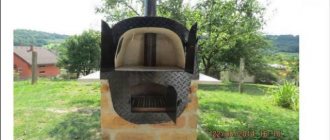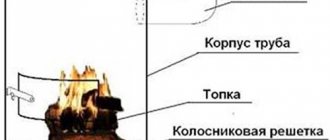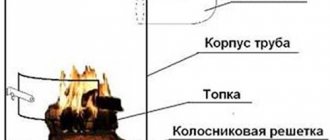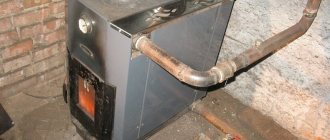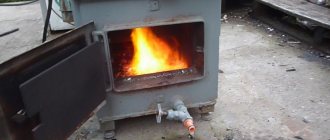The Slobozhanka stove with a long burning time is suitable for heating garages, utility rooms and buildings in summer cottages. It is also installed in greenhouses, workshops and storage rooms. This is a simple device that can be easily assembled yourself if you have some experience in carrying out such work and the appropriate tools and materials.
General view of the Slobozhanka stove
Laying firewood and ignition
In order to put firewood into the combustion chamber, it is necessary to lift the press from the outside by the pipe protruding from the stove. Make a bookmark and light the fuel on top. You can open the firebox door halfway. In this case, the open end of the 80 mm pipe must be closed, for example, with a small piece of steel sheet. The damper on the chimney opens completely.
In this position, the stove should operate on solid fuel for about twenty minutes so that it warms up well. When all the wood has burned out, it is necessary to remove the remaining fuel and ash from the firebox and make a new stack. This firewood is set on fire from above; for this you can use paper, cardboard, dry branches and other materials. As soon as the main fuel ignites, the press is lowered onto it, the firebox door is closed, the 80 mm pipe is opened, and the chimney pipe damper is closed halfway.
The firewood smolders, releasing pyrolysis gas, which, together with a small amount of smoke, passes into the gap between the edges of the press and the walls of the stove. In the second chamber, the gas is mixed with heated air, which enters through holes made in the 80 mm pipe. Through it, the bulk of the air enters the upper firebox, the minimum - into the smoldering zone of the firewood. The air is heated by passing through a pipe, which is located in the very heart of the flame obtained from the combustion of pyrolysis gases.
This is one of the simplest designs that you can quickly make with your own hands. For a heating system in a small house, this is the most acceptable option. Practice has shown that one bookmark is enough for 12 hours.
Modernization of a potbelly stove
Installing a potbelly stove in a garage will provide warmth and comfort. But the efficiency of this furnace can be increased by 10-15%. Here is a list of technical solutions:
- Installing a brick jacket on the back and sides - we have already talked about this. The thickness is half a brick;
- Installing a chimney with a long horizontal section - it will retain some of the heat escaping into the chimney. We put the stove in one corner, extend the chimney to the other, and then take it upstairs;
- We cover the walls with steel sheets - they will reflect infrared radiation back into the room;
- Installing a steel jacket around the stove - we surround the potbelly stove with steel sheets located at a distance of 40-50 mm from its walls. This solution forms a convector that forces air to circulate throughout the garage.
This is quite enough to “squeeze” the maximum thermal energy out of the stove. When installing a furnace to heat your garage, do not forget to take care of purchasing a fire extinguisher.
Hello! For heating, I purchased a Butakova stove, model student, power 9 kW
Because I’ve never encountered such stoves before and there’s not much space in the garage. The question arose: where is the best place to put it?
There are several options
1)
The first option immediately disappears because curtain, and the minimum distance to flammable materials should be 50 cm. But at the same time, the machine can be placed closer to the racks and ensure the maximum distance to the stove.
2)
The second option, according to the rule, with an indentation of 50 cm. But the stove will be located near the gas tank and I don’t like this, the distance between the stove and the car is 90 cm. Also, the wall with the gate is frozen with frost, when the firebox is fired it will all run away
3)
I'm leaning towards the third option. There is a closet in the corner, a very convenient place for it. Step back 50 cm from the cabinet and install the stove. The stove will be located relative to the car opposite the rear wheel or rear door, depending on how you stand. The chimney will be straight into the roof, and not like many do into the wall, so the location of the stove is free. Also, the stove will be located closer to the center of the garage, which will give more uniform heating. And the work area is near the racks; there is no point in heating the gates.
And another question: a stove can be heated for up to 8 hours on one stack. What should you do in the following situation, for example, you lit the stove, did everything, and the stove is still heating? You can’t leave it unattended; you don’t want to sit and wait for several hours until the firewood burns out.
Comments 57
Why can't it be left unattended? make a proper hood for it so that nothing falls off, and you can leave it, I have a Buleryan, I leave it in the minimum burning mode, although it is on the left hand, in the same place as your stove, only on the side of the “face” of the car
Great thing, this stove. Recently I had the opportunity to work in an ordinary metal garage, although I don’t know how and with what it was insulated, but the fact that it was insulated is exactly where such a stove was installed. The garage warmed up to a comfortable temperature very quickly)
what kind of stove? is there any information on it?
professor-butakov.ru/pb/Butakov’s stove an improved version of buleryan
In order not to wait 8 hours, you can bookmark less. In general, there is a gun for short-term work. Although manufacturers focus on the fire safety of their product...
The stove should be as close to the gate as possible, but because of the curtain, then option No. 2 will do, but I would advise putting some kind of screen between the machine and the stove. From my own experience, I have a homemade potbelly stove using option No. 1, and one day in severe frosts when I was heating the garage, I decided to lean on the rear left fender of the car and almost burned my hand. The car got very hot from the stove, and the body itself, the tire and rim, and the bumper... I think your stove has a much higher efficiency than mine, so I advise you to put at least a sheet of metal between it. The further the stove is from the gate, the worse it warms up garage. I originally had it at the back wall and it turns out that it’s hot at the back wall, but it’s cold coming from the gate.
Very often, a potbelly stove is used to heat a garage. Moreover, you can do it yourself, but you don’t need to spend money for it. It is enough to look in the bins for unnecessary metal parts.
Operating principle
The Slobozhanka stove has the following operating principle. The fuel burns gradually, starting from the top layer and ending with the very bottom, that is, from top to bottom, and not from bottom to top, as in classic stoves.
The air heats up and transfers thermal energy to the walls of the housing, rises upward, warming up the chimney.
The degree of oxygen supply intensity, and therefore the temperature, the intensity of combustion (smoldering) is regulated by dampers, there can be several of them, it all depends on the design features of a particular model.
The combustion chamber has a “jacket” through which cold air is sucked in from below, heats up as it passes through, and when leaving the stove heats the room, ensuring continuous circulation of air masses. In most cases, the volume of heated air is regulated using a reflector cover, which also allows you to regulate the temperature in the room.
From theory to practice
So, let's move from theory to practice. Let's take a model with a central air supply to the combustion chamber.
We need to make an air supply and distribution channel. It is made from thick-walled pipe. Just take a piece of pipe along a length not exceeding the height of the combustion chamber. A bolt needs to be welded at the bottom. Then cut a piece of sheet steel with a diameter equal to the diameter of the pipe, drill a hole and secure it to the bolt using a nut. It turns out that the pipe in the lower part is closed by a coin that moves along the axis, and the intensity of oxygen supply to the firebox depends on how closed the section is, and therefore the nature of fuel combustion and the temperature in the room. Using an angle grinder, cut grooves in the pipe to supply air to the firebox with a width of at least 10.00 mm. It is also necessary to weld the circle. To do this, cut a “pancake” out of steel - a circle with a diameter smaller than the diameter of the combustion chamber; cut a hole in the center corresponding to the diameter of the pipe. All that remains is to put a circle on the pipe, 20-30 centimeters long, and weld it. Now let's move on to the body. You can use a gas cylinder, a barrel, or weld a sheet steel cylinder. In a cylinder or barrel it is necessary to cut off the top part, and in the cylinder the bottom must be welded; A hole for the chimney with a diameter of at least 100 mm is cut in the upper side part of the body to remove combustion products and a pipe of the appropriate diameter is welded; A hole is cut in the center of the bottom for installing a pipe made by us for supplying oxygen. The diameter of the hole is equal to the outer diameter of the pipe, which is installed as an air duct; Let's move on to making a heat-dissipating disk. Use sheet steel 10 mm thick. Cut a circle with a diameter slightly smaller than the diameter of the body; you can weld a handle from steel wire or fittings for convenience; Next we need to make a convection jacket (stove casing). To do this, take sheet steel and weld a cylinder with a diameter several centimeters larger than the diameter of the main body of the stove. It’s hard to imagine the Slobozhanka oven without a convection jacket; We connect the main body and the convection jacket. To do this, you can use solid or tubular type cylinders with heads. Make the holes using a drill. Then secure the heads to the rivets using a riveter; Making a cover for the main body
You can take the cut off top of a cylinder or the lid of a barrel and weld handles from rebar or large-diameter steel wire; Important condition. The stove must be located at least 25 centimeters above the floor level. This is necessary to ensure air circulation in the convection jacket
Therefore, do not forget to weld the legs, for example, from a corner of the appropriate length to the body
This is necessary to ensure air circulation in the convection jacket. Therefore, do not forget to weld the legs, for example, from a corner of the appropriate length to the body.
As you can see, assembling the Slobozhanka stove yourself is not easy, but very simple. The only thing is, as noted above, heating devices of this type can differ significantly in design features, so adhere to the selected drawing and the general recommendations specified in our article.
Bubafonya
If the above-mentioned stoves that support long-term combustion must, in most cases, be purchased at specialized retail outlets, then the heating devices discussed below can be made independently, if you have the necessary materials, tools and skills, which reduces the cost of the equipment. In some cases, craftsmen can assemble both Buleryan and Butakova at home, on their knees, but this applies to extreme sports.
Therefore, greenhouses are heated in most cases with homemade stoves that support long-term combustion.
One type of such heating equipment is Bubafonya. At its core, it is a convection oven with a body made of a barrel or gas cylinder, into which various types of solid fuel are placed through the door. An ash pan is provided at the bottom. And smoldering is ensured by the fact that a metal pancake with its own weight exerts constant pressure on the burning wood or other type of fuel from above. Thanks to this, greenhouses on one tab can be heated for quite a long time.
Slobozhanka
Greenhouses can also be heated with such a type of convection ovens as Slobozhanka, which are also called “super potbelly stoves”.
This stove consists of:
- combustion chambers;
- air supply and distribution channel;
- convection shirt;
- additional elements (everything directly depends on the design features of a particular model).
The Slobozhanka stove can be purchased in specialized stores or assembled with your own hands; there is nothing complicated about it.
The main difference between this type of long-burning convection ovens is the upper system of ignition and combustion of fuel, and the supply of oxygen from below the firebox.
In this case, combustion can be:
- upper side;
- top center.
Let us highlight three main types of Slobozhanka stoves:
- with an L-shaped pipe for lateral oxygen supply into the combustion chamber;
- with air supply through the central part using a guide pitoid;
- with air supply from the lower side part.
Thus, regardless of the method of supplying air to the combustion chamber, the most efficient heat exchange is ensured.
We also note that installing Slobozhanka stoves in greenhouses is also beneficial for the reason that various materials can be used as fuel, from classic firewood to pine cones and needles.
As you can see, there are many long-burning stoves that differ in design features, functional purpose, cost and a number of other parameters. And we have listed only the main, but not all types of convection, gas-generating heating devices that can be used in greenhouses. The choice is yours, we only note that the long burning of fuel, which is provided by stoves of this type, allows you to maintain a certain temperature regime in greenhouses over a long period of time.
Types of fireplace stoves
The design discussed above is the simplest implementation of the idea of a fireplace-stove. In fact, there are much more efficient and functional structures that combine a separate fireplace and stove, install a hob, oven or heat exchange niches, etc.
Fireplace stove with bench
Fireplace stove with bench
A massive structure with a heated lounger or stove is not suitable for every home. For example, for a summer house it will be too big, since it will occupy a significant area of the room. If you install such a unit in a country house, you can achieve amazing comfort: such a design just begs to be installed in a living room combined with a kitchen.
Wall fireplace stove
A wall-mounted fireplace stove will save space in a small room
This design can be built in a small house to heat two adjacent rooms. As in the design discussed above, heating units can be heated separately. In this case, the fireplace can be used to quickly and comfortably heat a large room, while the heating of the back wall during operation of the stove will work to heat the bedroom. The disadvantage of this design can be considered the absence of a hob, which, however, is compensated by the compactness of the structure.
5220993d8a99101d96adbf2cb261e672.jpe
87e4199ded4b8661b2dd1e0235b55992.jpe 1e4d6cd87019e985f14ece023e868111.jpe 488eeeca13d0ce1bcbeb499f595cb697.jpe
Square fireplace stove with stove and oven
Multifunctional fireplace stove with stove and oven
A multifunctional heating device installed in a large room can divide it into several zones. On the side of the fireplace, you can create a cozy homely atmosphere for relaxing and gathering with friends, while the area adjacent to the stove can be used for cooking and other household needs. Fortunately, for this purpose the fireplace stove has a large hob and a spacious oven. The shelf above the fireplace can also be used to the maximum - it is convenient to dry fruits, mushrooms or medicinal plants on it.
Materials for making a long-burning stove
Long-burning stoves can be made by hand from sheet metal or various metal structures. Examples and drawings of such stoves are given below.
Barrel stove
A home-made heating device intended for heating utility rooms, made from a two-hundred-liter metal barrel. The stove runs on sawdust, shavings and other woodworking waste. Inside the large barrel, a small barrel for loading fuel is installed on a stand. Underneath is an ash pan - a drawer made of sheet metal.
The stove itself is placed on a stand, the role of which is played by a car disk. A smoke pipe is made from pipe scraps with a diameter of 100-150 mm. The barrel is equipped with a sheet metal lid with a handle and an opening for air supply.
A log sharpened to a cone is installed inside a small barrel; it is indicated in the drawing. Sawdust is poured around it. After compaction, the log is removed and the sawdust is set on fire. During the smoldering process, gas is released into the space of a large barrel, where it is burned.
Furnace with water circuit made of metal pipe
A homemade long-burning stove made of a metal pipe, which can burn wood or sawdust, is equipped with a water circuit. Loading is done from below; to intensify combustion, an air distributor is installed inside the stove, pressing the smoldering wood.
A telescopic hollow pipe is installed in the center of the disk, through which air flows directly into the combustion chamber, where, thanks to the ribs welded onto the disk, it is evenly distributed over the entire surface of the firewood. It lowers on its own as the fuel burns out. You can lift it before loading using a cable.
The loading door is located in the center of the oven. At the bottom there is a cleaning door and an ash pan. At the top there is a chimney. The stove is equipped with a water circuit with pipes for water inlet and outlet. Such a stove with a water circuit can heat small houses and other premises quite efficiently, and you can make it with your own hands from scrap materials.
Furnace from a waste gas cylinder
A stove can be made from a gas cylinder without extra costs or searching for suitable material. The dimensions of the 50-liter cylinder are perfect for making such a stove, and the wall thickness and tightness make it safe to use.
The design of the furnace as a whole does not differ from the previous model, this can be seen in the drawing. A propane tank with a cut off top is used as a body. You can make a lid of a suitable size from sheet metal with your own hands, with a hole for the air distributor pipe. Fuel is loaded through the top, filling the volume of the cylinder almost to the chimney. This stove operates on sawdust and other waste, as well as small firewood. The fuel is carefully compacted, ignited using wood chips or an ignition agent, an air distributor is installed, and then covered with a lid.
The efficiency of such a stove is quite high, and thanks to its sealed housing, it can be used to heat rooms where people stay for a long time. If desired, it can be equipped with a water circuit by passing the chimney through the boiler.
No. 1. Water heating system
The water heating system is organized in the garage by analogy with residential premises. The coolant is heated in the boiler, and then it passes through pipes and radiators, uniformly heating the entire garage room. After the heat supply stops, the pipes remain heated for another couple of hours. This is the main advantage of this system.
The main disadvantage is the complexity of the organization. In addition, the water in the heating circuit may freeze, so if the system will not be used in the coming days, it is better to drain the water. On the other hand, frequent water changes lead to rapid corrosion of pipes and radiators. To avoid this problem, it is better to use metal-plastic equipment. It is better not to use ordinary water in the heating system - it is replaced with antifreeze, a non-freezing coolant.
The complexity of the arrangement results in another drawback - the high price. The most economical way to heat a garage is to connect its circuit to a home boiler. The cost of general heating will increase, but it will still be cheaper than organizing an independent heating system.
If it is not possible to connect to your home system, you will have to install a separate boiler. It can run on different fuels. The following types of boilers are used in the garage heating system:
- An electric boiler is the easiest to install, extremely safe, but expensive to operate. Even if you are not worried about electricity bills, you should not use such boilers in areas with frequent power outages, power surges, or in regions with severe windy winters, because the wires may break, which will ultimately lead to freezing of the water in the system. If you do not manage to drain the water in time, the pipes may burst;
- gas boilers are used extremely rarely in garages, since not everywhere there is access to a gas pipeline. If the gas pipeline runs nearby, then you are very lucky - gas heating is inexpensive, and such systems are quite simple in terms of operation. The main thing is to follow safety precautions;
- boilers for liquid and solid fuel. You can choose a stove that runs on wood, coal, diesel or waste oil - it all depends on which resource is more accessible in your case. Solid fuel boilers require constant monitoring and frequent loading of fuel. Pyrolysis and pellet units are more convenient in this regard, but they are not cheap; the most economical option is a potbelly stove, which can also be used in a water heating system.
For all boilers, except electric ones, you will have to organize a chimney. In addition to the boiler, radiators, heating pipes and chimney pipes, you will need a circulation pump and an expansion tank. All this costs money, so using a hydronic heating system only makes sense in large garages. Often such heating is done at service stations and commercial auto repair shops. If the garage is small, then there is no point in organizing such a complex water heating system - this is an option for more or less spacious rooms where constant heating is required.
The operating principle of a water heating system is quite simple. The coolant heats up, passes through the pipes, gives off heat and returns to the boiler. The system can be one- or two-pipe. A single-pipe system is much easier to organize and cheaper; it is best suited for a small private garage. In this case, the heated coolant sequentially enters the radiators, i.e. in the first radiator the temperature will be higher than in the last, where the antifreeze reaches it already cooled down. The two-pipe system allows for more uniform heating, but much more materials will be needed.
Even if the garage is not attached to the house, but is located nearby, you can try to connect it to the home heating system, but there are limitations. The distance from the garage to the house should not be more than 20 m, and the pipes must be properly insulated.
The coolant is replaced every 5 years.
Butakov stove
Convection ovens developed by Professor Butakov are widely represented on the market and can be used for heating greenhouses, although this option is also used quite rarely.
This heating equipment is produced by various manufacturers, including companies:
- Zubkevich is the developer of furnaces of this type;
- Termofor is one of the largest manufacturers, for which Zubkevich developed the model;
- Teplodar is a clone, although a very successful one;
- Convection.
Furnaces from different manufacturers have both their advantages and disadvantages. When purchasing, rely on expert recommendations and reviews.
The operating principle and functional purpose of this type of heating equipment fully corresponds to Buleryan stoves.
The stove body is a parallelepiped in which convective air pipes and a two-chamber firebox are located.
Also provided:
- ash pan;
- flap;
- chimney.
Comparative characteristics of long-burning furnaces with traditional heat generators
The operating principle of most heating units is based on fast and intense combustion of fuel. The fuel is ignited from below, the fire spreads, and oxygen access to the combustion zone is open. The disadvantages of this heating method are sudden temperature changes, incomplete combustion of the fuel resource with the formation of a large amount of soot and soot, the need to frequently add fuel and regulate draft.
The operating principle of long-burning furnaces is completely different. The fire moves from top to bottom, which allows the combustion space to be fully loaded. Fuel is used gradually, its combustion occurs in the direction from top to bottom. Air is supplied directly to the fire. This type of combustion is a slower process with less heat release.
This allows you to maintain an even, comfortable temperature, which is very important for greenhouses.
In this category of furnaces, the most economical are pyrolysis (gas generator) models, in which gases formed as a result of slow combustion - smoldering - of fuel are burned. The efficiency of such a unit increases significantly, and fuel costs are reduced.
The temperature of the gases discharged into the chimney is quite low, which leads to the formation of condensation. Therefore, insulated chimneys are installed for pyrolysis furnaces.
Such stoves operate in two modes - intensive and long-term combustion. At the beginning of the heating process, the temperature is brought to the required value, and then the draft is closed and the unit is rebuilt into an economical mode.
Advantages of long-burning gas-generator heating devices:
- In the presence of relatively inexpensive solid fuel, long-burning stoves are an economical and efficient (efficiency up to 85%) method of heating greenhouse premises. The cost of many models is also quite affordable.
- Fuel is loaded 1-3 times a day, a comfortable temperature after reaching the required value is maintained by the traction force in the firebox.
- With the help of such furnaces it is possible to organize air and water heating systems and water heating.
There are several types of long-burning heat generators used for heating greenhouses. They can be either homemade or factory-made.
Initial conditions
- The garage is generally visited twice a day or even less often. Therefore, the heating method we choose should be sufficiently autonomous and not require constant attention. Steel potbelly stoves can be eliminated immediately: after kindling, the room will cool down in a couple of hours.
- The room has a small volume. We have already mentioned the case of the garage-workshop; however, in most cases a moderate heat output is required.
The price of materials or a ready-made solution should not be prohibitive. Most car enthusiasts, you know, are not interested in investing in installing a geothermal heat pump in the garage.
Furnace structure
So what is the design of the furnace?
This is a vertical stove with one combustion chamber, into which fuel is loaded from above. Or rather, not just from above, but from above and from the side. This allows you to conveniently load fuel, including during the operation of the stove, without waiting for the first fill to burn out. At the bottom of the stove there is a hatch for removing ash, which makes it easier to maintain the heating device. On industrially produced models, special dampers are installed to regulate the air supply and gas exhaust. A casing is fixed over the combustion chamber, passing through which the cold air is heated and exhausted back to heat the entire room. A special chimney removes volatile combustion products outside the room.
The Slobozhanka stove drawing can be easily found on the Internet in the public domain. The inventors do not hide the characteristics of their development. On the contrary, in their opinion, Slobozhanka will enjoy special trust and demand among rural residents after they learn more about her.
"Bulleryan" and "Slobozhanka"
The first type of stove for greenhouses is used extremely rarely. This is a convection type design that can maintain the required temperature for a long time. Regular firewood and wood products are used as fuel. However, there are also disadvantages to installing such a stove; it is not very convenient; you need to constantly add fuel. In addition, there is no temperature regulator.
The appearance resembles a horizontal barrel with exhaust pipes on top. For the smallest model, it is possible to pass air in amounts of up to 5 cubic meters. m. in one minute. In this case, the body does not heat up.
“Slobozhanka” resembles a classic potbelly stove, but the operating principles are different. Heat exchange is carried out in this way:
Scheme of operation of the Slobozhanka furnace.
- thermal radiation;
- heat transfer;
- convection.
We can say that the Slobozhanka device contains three different units:
- gas generator;
- the oven itself;
- heater.
The body itself is externally a barrel-shaped oval. It has a two-tier firebox, through which seven vertical pipes pass (for some systems there may be more). The pipes go to the center of the firebox in a bent state.
The design provides:
- the presence of a draft regulator;
- smoke damper;
- door for loading firewood.
There is no tray to remove combustion products; it must be placed separately. A greenhouse equipped with such a stove can heat up quite quickly, but there is one big drawback - fuel must be supplied regularly.
General information
We all know how quickly wood burns in a stove, often not providing as much heat as desired. But in brick this process continues not only longer, but also with greater efficiency.
In most cases, this depends on the draft and the chimney, for which in the first it is increased, and in the second it is adjusted with a special damper. Then the heat “does not fly out into the chimney”, but accumulates on the chimney or the stove itself.
If there is not enough of it, it will become smoky and dull, and blue lights will run through it. In this case, the firewood will, of course, burn longer, but it will not be possible to achieve the required temperature in the firebox.
The name “long-burning stove” appeared due to the fact that heating devices changed their technical characteristics.
- have a powerful heating element that allows water or air heating of the greenhouse;
- do not depend on the gas supply system; firewood or wood products can be used as fuel for a long time;
- Efficiency is about 85%;
- ease of maintenance;
- efficiency.
The design of long-burning cast iron stoves differs from conventional ones, where the main “accumulator” of heat is red brick. Metal heats up faster, but also gives off heat. Therefore, in order to increase the heat transfer time, a conceptual decision was made - to reduce the combustion rate, for which the oxygen supply was reduced.
The photo shows the “Vologda” stove
Although the fuel in this case cannot give the same combustion temperature as in the traditional mode, it is enough to heat the metal walls to 60 - 70˚C, which corresponds to heating the surface of a conventional red brick stove after the end of the active firebox.
However, heat begins to radiate from the device after 30 minutes, and not after 1-1.5 hours. This parameter is the main trump card for manufacturers, which is based on the fact that you do not need to constantly monitor the stove; it is enough to throw firewood into it two or three times.
General Tips
Construction of a furnace is a labor-intensive process with many nuances. Here are the main ones:
- if the foundation is poured in excessively hot weather, then it must be moistened from time to time so that the screed does not crack;
- the first row is laid out dry, so it needs to be formed from even bricks that can be tightly fitted to one another;
- to achieve the desired plane surface of the brick, it can be trimmed with a grinder;
- hewn or chipped bricks cannot be placed with the damaged surface inside the furnace, since on this side the material is less refractory;
- Any cast iron elements cannot be installed flush with the masonry, so that it does not collapse; make a layer of mortar or clay.
Baking in a summer kitchen is not only convenient, but also delicious. With a barbecue you can easily cook meat over coals, and a cauldron will help you prepare wonderful soups or porridges over a live fire. And it always adds piquancy to any dish.
Features of the Slobozhanka stove
The Slobozhanka oven is a type of convection oven. Such a stove produces warm air and thereby gives warmth to the room. The air is heated by combustion that passes through the outer casing of the chamber. Cool air at a distance of 10-15 cm from the floor is naturally absorbed into the skin, thereby moving upward. Warm air enters the room and releases heat.
The Slobozhanka stove has two operating principles:
1. central;
2. lateral.
A certain amount of solid fuel is placed in a chamber that serves to burn it. Then lay a small amount of wood chips and paper on top. When bringing matches or a lighter, the fire ignites the paper, and after ignition, you must immediately close the lid (damper). After this, the Slobozhanka must do the work independently without any outside interference. The draft in this oven works flawlessly. At the very beginning, air is supplied to the very bottom of the combustion chamber, and only after that into the chamber where the fuel is stored. Due to the fact that Slobozhanka’s design is simple, the manufacturer has acquired a long-burning stove. This stove can provide heat in a room for up to 12 hours with one fuel supply.
Advantages
Let us note the main positive aspects in the operation of stoves for long-burning greenhouses:
- easy to operate;
- economical;
- independent from electricity and gas supply;
- high efficiency - 80-90%.
Long-term combustion of such devices is ensured through the pyrolysis process. The fuel in the chamber does not burn, but gradually smolders with minimal air access and forms a large volume of pyrolysis gases. The released gases burn in a separate chamber and release heat. With this combustion process, the efficiency and effect are much higher than those of conventional traditional stoves.
Internal structure of the long-burning stove "Bubafonya"
Let's look at the bubafoni device. An old household gas cylinder is the base of the stove. The wood inside the bubafoni burns. Pyrolysis, as the basis of the process, decomposes wood at high temperatures into gases, which, when burned, generate thermal energy. Wood burns in stages:
- Stage No. 1 - the fire heats the wood, burning out light flammable substances. Having crossed the two hundred degree bar, the firewood decomposes into simple substances and the gas begins to burn.
- Stage No2. This stage of combustion is the most efficient, as the gases are heated to a temperature of 700 degrees Celsius.
- Stage No3. We get what this device can provide - the required heat.
Construction of a pyrolysis boiler. The inner chamber is divided into two parts. This makes it possible to burn solid fuel in one chamber, and burn pyrolysis gas in the second. In the chamber below, which is filled with wood, the initial burning of the wood takes place. In the upper part, it is filled with wood combustion products, which ignite. The heavy press pushes the fuel down, and the wood is burned efficiently. At the top of the firebox there is a hole to which the chimney is connected, and the smoke leaves the stove through this system. Air enters the combustion chamber through an air duct located on one structure of the press. The air supply is regulated by the air duct damper.
ea24bcaf0815949fba201b0edfccd052.jpe
The second method or boiler No. 2
A pyrolysis boiler with a water heater, which does not require electricity or automation, works on the principle of counteracting the two laws of the square-cube. This refers to the laying of fuel and lining of fireclay bricks. Algorithm for the operation of a brick kiln:
At the beginning, the intensity of the pyrolysis process is ensured by the sublimation of the lightest volatiles. The “first heat” travels through the smoke circulation, being absorbed by the lining. At the stationary stage, the lining serves as a thermal buffer: when there is excess pyrolysis heat, it absorbs it and releases it when it cools. Upon completion of carbonization of the fuel, heat is gradually released by the lining, preventing the temperature from falling below the critical point.
Loading firewood or coal into a boiler with a heat buffer is done gradually. Sharp temperature fluctuations are contraindicated for her. If too sluggish fuel is used, it may stall. If it is too flammable, there is a risk of an emergency. If the first heat is not suppressed, the efficiency will not exceed 76-78%, since instantaneous heat transfer from the lining to the outside is excluded.
Details about long-burning stoves
Slobozhanka stove is a concept that denotes a whole group of long-burning units. They all differ in three ways.
- Firebox capacity.
- The presence of a secondary ignition element in the design.
- Method of supplying air to the firebox.
This variability does not negate the essence of such models: they all use a combustion system and are capable of extracting energy only from solid organic fuel. Methods for supplying oxygen to the furnace:
https://youtube.com/watch?v=zXMsz_mj9vM
- welding a pipe in the shape of the letter “L” to the bottom of the combustion compartment;
- connecting the channel directly in the center of the bottom of the tank (distribution also goes upward);
- pipe contact on the lower side section, which ensures excellent heating of the tank walls.
The combustion process itself can be realized in two ways. The choice between them depends on the design parameters of the air distribution channel, the configuration of the delivery unit and the type of air supply system to the raw material splitting zone. There are 2 types of combustion (operating principles).
| Combustion | Principle of operation |
| Upper side | The fuel burns from above towards the bottom of the chamber and is inclined at a certain angle to the chimney |
| Central | Also goes from top to bottom, but the flame is distributed to the periphery of the firebox |
Regardless of which option you take as a basis, you will definitely need the appropriate drawings. If everything is done correctly, your home-made stove will definitely provide the required heat exchange, and, consequently, operational efficiency.
Unlike classic heating units, long-burning furnaces convert raw materials into energy starting from the upper rather than the lower layers. This ensures the most optimal conditions for absolute combustion of fuel. The heated air transfers heat to the body and rises, which causes an increase in the temperature of the chimney.
The efficiency of the furnace is up to 90%. By changing the intensity of oxygen supply, heating can be controlled. This is done using three dampers. The chamber is equipped with a so-called “jacket” through which cold air passes from below. As it heats up and leaves the device, it fills the room, thereby ensuring constant air circulation.
Design and principle of operation of the Slobozhanka stove
